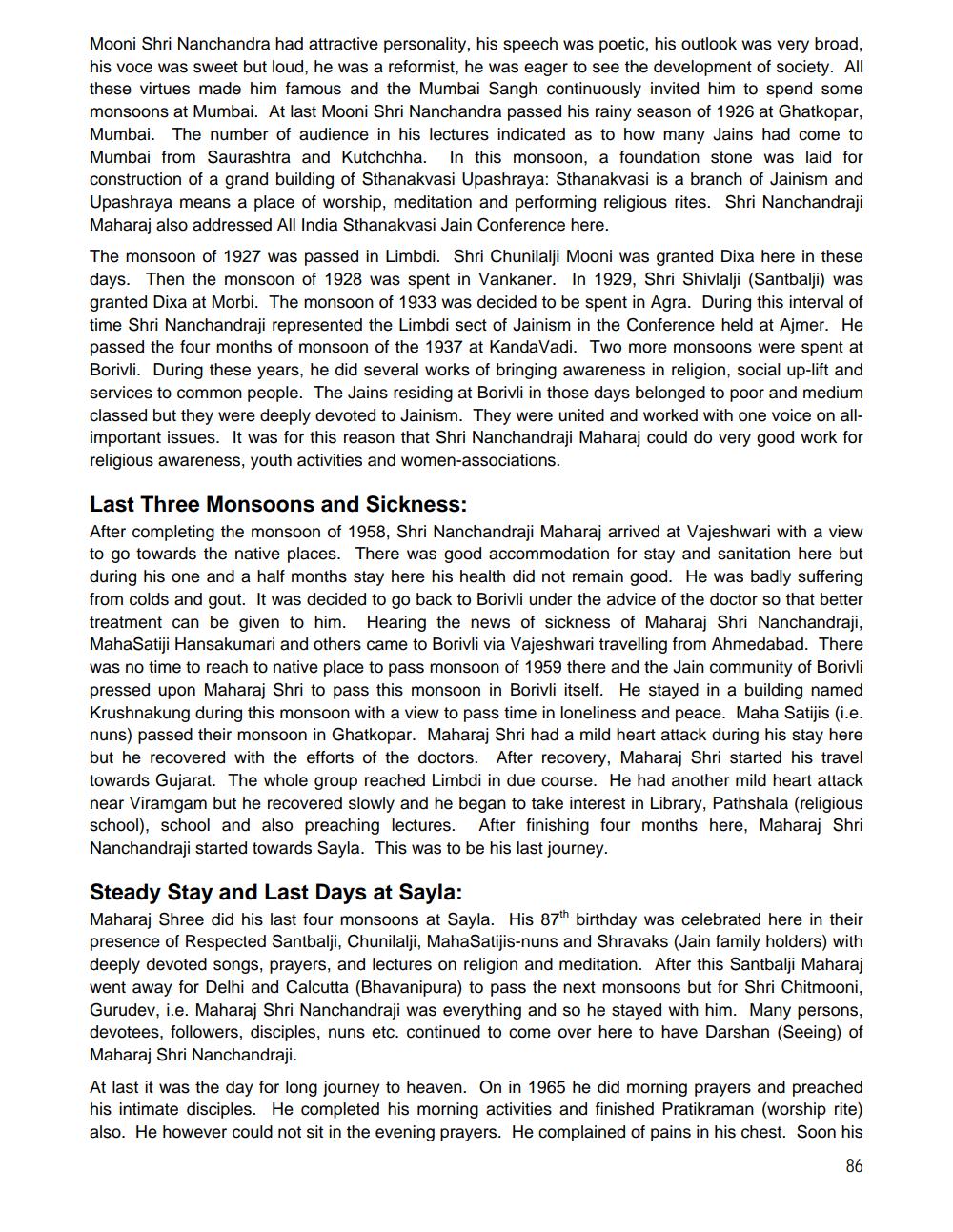________________
Mooni Shri Nanchandra had attractive personality, his speech was poetic, his outlook was very broad, his voce was sweet but loud, he was a reformist, he was eager to see the development of society. All these virtues made him famous and the Mumbai Sangh continuously invited him to spend some monsoons at Mumbai. At last Mooni Shri Nanchandra passed his rainy season of 1926 at Ghatkopar, Mumbai. The number of audience in his lectures indicated as to how many Jains had come to Mumbai from Saurashtra and Kutchchha. In this monsoon, a foundation stone was laid for construction of a grand building of Sthanakvasi Upashraya: Sthanakvasi is a branch of Jainism and Upashraya means a place of worship, meditation and performing religious rites. Shri Nanchandraji Maharaj also addressed All India Sthanakvasi Jain Conference here.
The monsoon of 1927 was passed in Limbdi. Shri Chunilalji Mooni was granted Dixa here in these days. Then the monsoon of 1928 was spent in Vankaner. In 1929, Shri Shivlalji (Santbalji) was granted Dixa at Morbi. The monsoon of 1933 was decided to be spent in Agra. During this interval of time Shri Nanchandraji represented the Limbdi sect of Jainism in the Conference held at Ajmer. He passed the four months of monsoon of the 1937 at KandaVadi. Two more monsoons were spent at Borivli. During these years, he did several works of bringing awareness in religion, social up-lift and services to common people. The Jains residing at Borivli in those days belonged to poor and medium classed but they were deeply devoted to Jainism. They were united and worked with one voice on allimportant issues. It was for this reason that Shri Nanchandraji Maharaj could do very good work for religious awareness, youth activities and women-associations.
Last Three Monsoons and Sickness:
After completing the monsoon of 1958, Shri Nanchandraji Maharaj arrived at Vajeshwari with a view to go towards the native places. There was good accommodation for stay and sanitation here but during his one and a half months stay here his health did not remain good. He was badly suffering from colds and gout. It was decided to go back to Borivli under the advice of the doctor so that better treatment can be given to him. Hearing the news of sickness of Maharaj Shri Nanchandraji, MahaSatiji Hansakumari and others came to Borivli via Vajeshwari travelling from Ahmedabad. There was no time to reach to native place to pass monsoon of 1959 there and the Jain community of Borivli pressed upon Maharaj Shri to pass this monsoon in Borivli itself. He stayed in a building named Krushnakung during this monsoon with a view to pass time in loneliness and peace. Maha Satijis (i.e. nuns) passed their monsoon in Ghatkopar. Maharaj Shri had a mild heart attack during his stay here but he recovered with the efforts of the doctors. After recovery, Maharaj Shri started his travel towards Gujarat. The whole group reached Limbdi in due course. He had another mild heart attack near Viramgam but he recovered slowly and he began to take interest in Library, Pathshala (religious school), school and also preaching lectures. After finishing four months here, Maharaj Shri Nanchandraji started towards Sayla. This was to be his last journey.
Steady Stay and Last Days at Sayla:
Maharaj Shree did his last four monsoons at Sayla. His 87th birthday was celebrated here in their presence of Respected Santbalji, Chunilalji, MahaSatijis-nuns and Shravaks (Jain family holders) with deeply devoted songs, prayers, and lectures on religion and meditation. After this Santbalji Maharaj went away for Delhi and Calcutta (Bhavanipura) to pass the next monsoons but for Shri Chitmooni, Gurudev, i.e. Maharaj Shri Nanchandraji was everything and so he stayed with him. Many persons, devotees, followers, disciples, nuns etc. continued to come over here to have Darshan (Seeing) of Maharaj Shri Nanchandraji.
At last it was the day for long journey to heaven. On in 1965 he did morning prayers and preached his intimate disciples. He completed his morning activities and finished Pratikraman (worship rite) also. He however could not sit in the evening prayers. He complained of pains in his chest. Soon his
86




